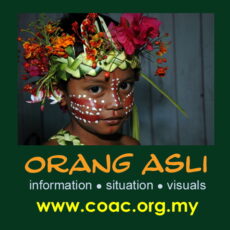Jen’s father, at left, at her graduation ceremony in February 2014.
Our condolences to Jenita, whose father died Friday night. Engi Isan, 61 years, had been suffering from a number of ailments after his heart surgery some years ago and had to be hospitalized on Friday morning when things took the turn for the worse. He was buried the next day in Kampung Parit Gong, Negeri Sembilan.
Friends and relatives had been trying frantically to contact Jenita, who was then still in Kampung Ulu Tual in Pahang which had no telephone service. The village is the site of the PDK Cenwaey Penaney community learning center which she helped establish with the community there.
Coincidentally, Friday-Saturday was when some of us decided to make a visit to Ulu Tual. Shafi from MyKasih and Alison from the Orang Asli Learning Project had scheduled this visit to see the progress of the community learning centre and to drop off some donations.
Unable to contact us, Yein had called the police station in Sungai Koyan to get their help in passing the message through to Jenita. At the village, although we knew that the police were looking for Jenita and me, I certainly did not expect the reason for their special visit. This service (or ‘duty’ as the officers told us) was much appreciated as they had to use a landrover to travel the 23km stretch of unpaved road to reach the village. The news however was not appreciated.
As it was already noon when we got the message, we immediately rushed off in Alison’s 4WD for Jenita’s home village. Soon after we met Yusri’s and his family (i.e Ibu, Miah, Arok and the little one) who were also coming in to Kampung Ulu Tual to inform Jenita of the news, as a backup in case the police did not deliver on the request to be a messenger.
Both our vehicles then raced for Parit Gong. When phone access became available Jenita got in touch with her family and informed them of her location. This was already 2pm, way past normal burial time for the Temuans (who, like most Orang Asli communities, need to bury their dead the same day, or the following afternoon if the death occurred at night).
Jen, with Yusri’s family just after they arrived in Parit Gong.
She pleaded with them to delay the burial a little. But the ritual elders were concerned that the threatening rainclouds would open up soon. Now in Yusri’s car, she raced to the village. But, alas, it was too late. She arrived at 3.30pm, half an hour after the burial ceremonies were completed. We can only empathize with Jen’s double sorrow, especially since she was very close to her father.
At the meeting of Lembaga Adat and family after the burial, it was decided that the mourning period would be 2 weeks (instead of the usual 7 days). The buka pantangceremony will thus be held on 27 November.
Menteri Engi Isan
Jenita’s father held the position of Menteri in the Lembaga Adat, the village’s Council for Tradition. He served during the time of the late Batin Sulim, then the most senior Orang Asli headman in the peninsula.
Menteri Engi, in blue shirt, handing over the ceremonial items to Batin Sulim during a traditional ceremony in 1997.
Menteri Engi greeting researcher Nobuta-san during the traditional ‘adoption’ ceremony in 1997, which was conducted in order for him to live and work in the village.
The Lembaga Adat is a traditional leadership structure common among Orang Asli groups in the south such as the Temuan and the Jakuns. The usually all-male positions includes the batin or headman (who is the highest authority), the Mangku (or deputy), the Menteri (adviser to the Batin), Penghulu Balai (custodian of the culture), Jenang (who officiates at marriages), Jurukerah (who organizes gotong royongs and such community work) and the Panglimas (the ‘warriors’ reseonsible for village security).
The members of the Lembaga Adat also have different social roles in the community, with the common objective of maintaining peace, continuity and the transmission of Temuan values to future generations.
However, many communities have given in to the pressure from the government to establish Village Security and Development Committees (JKKKs), where the normal committee-type posts are filled via an election process. These JKKKs have effectively replaced the Lembaga Adat in many communities. But not so in Kampung Parit Gong.
As Menteri, Engi Isan held the important role of advising the Batin on matters pertaining to the adat and the community.
The above photos are courtesy of Dr. Nobuta Toshihiro who did fieldwork among the Temuans of Parit Gong between 1996 and 1998 for his Ph.D. thesis, which has been published by COAC under the title ‘Living on the Periphery’ .
CN-COAC | 16 November 2014

